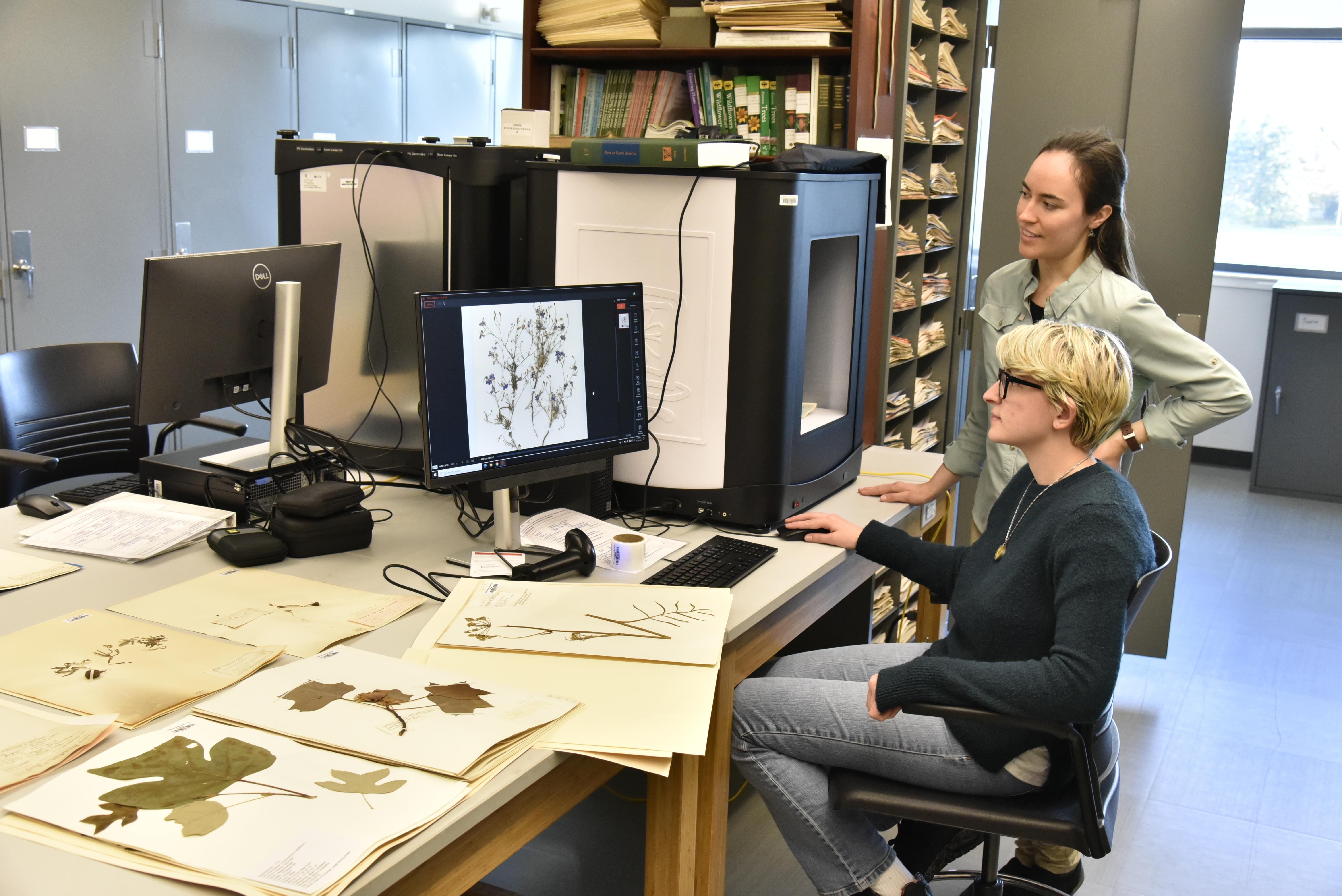SUNY Oswego student Logan Steckmeister (seated) works with Kristen Haynes, assistant director of Rice Creek Field Station, in the university's herbarium on a National Science Foundation funded project that will preserve and provide access to natural history while giving 20 students paid research experience.
The SUNY Oswego herbarium will preserve and provide access to natural history while giving 20 students paid research experience, thanks to a grant from the National Science Foundation (NSF).
The NSF will provide $224,784 in funding for the three-year effort, and there’s a lot to do for a project that Kamal Mohamed and Kristen Haynes –- the director and assistant director, respectively, of Rice Creek Field Station –- said has roots stretching back centuries while also branching into vast future use.
The collection numbers around 50,000 specimens, some of which date as far back as the 1800s, as well as important field notebooks in use over the years, Mohamed said. Its importance toward studying such key topics as biodiversity and environmental change mean its impact can expand well beyond the SUNY Oswego campus.
“Students will engage in all aspects, including curation, digitization, organization, mounting, inspecting and repairing them,” Haynes said. “But a key part involves scanning high-resolution images and importing them into databases. Putting them on these national and international web portals that host biodiversity collections, like the Consortium of Northeastern Herbaria and the Global Biodiversity Information Facility, will provide vastly greater access to the collection.”
The collection includes around 40,000 specimens that Syracuse University had been trying to find a new home for a few decades ago.
“These kinds of ‘orphaned’ collections were common at a time in the later 20th century when institutions decided to focus more on molecular biology and getting rid of natural history collections,” Haynes explained. “But with the advent of the internet and public online research collections, institutions that acquired or retained collections now can play a role as interest in the natural sciences returns.”
Mohamed was pleased that when plans for the Richard S. Shineman Center for Science, Education and Innovation came together about a decade ago, space for a proper herbarium was included.
Andrew Nelson, a longtime director of Rice Creek Field Station, was a key figure whose passion for the university and the botanical community resulted in preserving and transitioning the collection.
“Andy had just retired but he agreed to volunteer part-time because he loves local flora and the herbarium,” Mohamed recalled. “Because the specimens were old, they needed a lot of work. When he left, it was in fair shape and laid a great foundation.”
“Andy was so passionate but it was much more than one person can do on their own,” Haynes added.
Student experiences
Mohamed and Haynes stay apprised of NSF funding opportunities, and to have one supporting hands-on student work while providing accessibility to an important collection made plenty of sense. The field station already had a great relationship with SUNY Oswego’s EXCEL (Experiential Courses and Engaged Learning) Office in getting outstanding student employees.
“We want it to be meaningful,” Haynes said of the herbarium project’s opportunities for students. “We thought it was important to make this kind of hands-on opportunity available that introduces them to the field of natural history and valuable skills.”
Mohamed noted that, from the start of the project, they emphasized including diversity, equity and inclusion in their plans, to ensure students who otherwise might not have opportunities to learn about and enter the field could take part.
“Introducing underrepresented students into natural history and curation work is so important,” Mohamed said. “We’ve had a really good start.”
The project hosted two interns this fall, with three lined up for spring and the application for summer 2023 is already open on the university’s Handshake platform.
In addition to the hands-on experience, the internship will prepare students for their futures as they will learn more about career opportunities in the field and can broaden their networks.
The collection has a very wide biological and geographic scope, with specimens from every continent except Antarctica.
Providing online access to this wide range of samples means the collection can provide tremendous benefit to researchers and projects anywhere in the world.
“This is important for a lot of researchers looking at how climate change is impacting biodiversity, and things like the time of year that flora might flower or fruit,” Haynes said. “That’s why the NSF feels it is important to get this data online so everyone in the world has access to it.”
“We needed digitization and data entry to share the collection with the rest of the world,” Mohamed said. “We’re fortunate to have this grant to continue the work Andy started.”




